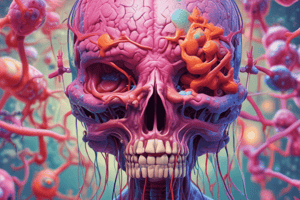Podcast
Questions and Answers
Which of the following practices is NOT part of standard precautions?
Which of the following practices is NOT part of standard precautions?
- Safe injection practices
- Isolation procedures (correct)
- Hand hygiene
- Use of PPE
Which statement accurately describes the difference between medical asepsis and surgical asepsis?
Which statement accurately describes the difference between medical asepsis and surgical asepsis?
- Medical asepsis increases the number of pathogens.
- Both eliminate all pathogens.
- Medical asepsis reduces the number of pathogens. (correct)
- Surgical asepsis reduces the number of pathogens.
What type of protective equipment is required for airborne precautions?
What type of protective equipment is required for airborne precautions?
- Gloves
- N95 respirator (correct)
- Face shield
- Surgical mask
Which factor can indicate that sterility has been compromised?
Which factor can indicate that sterility has been compromised?
Which emerging infectious disease is associated with antibiotic resistance?
Which emerging infectious disease is associated with antibiotic resistance?
Which method is NOT typically used to practice medical asepsis?
Which method is NOT typically used to practice medical asepsis?
Which of the following is a key nursing intervention for infection control?
Which of the following is a key nursing intervention for infection control?
What is the main goal of using contact precautions?
What is the main goal of using contact precautions?
What is a major characteristic of adaptive immunity?
What is a major characteristic of adaptive immunity?
Which of the following represents a component of respiratory hygiene?
Which of the following represents a component of respiratory hygiene?
Which stage of infection is characterized by the presence of mild and early symptoms?
Which stage of infection is characterized by the presence of mild and early symptoms?
What is the purpose of patient education in infection control?
What is the purpose of patient education in infection control?
How does a compromised immune system affect the risk of infection?
How does a compromised immune system affect the risk of infection?
Which of the following correctly describes latent infections?
Which of the following correctly describes latent infections?
In the chain of infection, what does the 'portal of exit' refer to?
In the chain of infection, what does the 'portal of exit' refer to?
What is a common symptom of systemic infections?
What is a common symptom of systemic infections?
What type of immunity involves B cells and T cells?
What type of immunity involves B cells and T cells?
Which factor is NOT commonly associated with an increased risk of developing infections?
Which factor is NOT commonly associated with an increased risk of developing infections?
Which type of infection has a rapid onset and short duration?
Which type of infection has a rapid onset and short duration?
In which stage of infection is the immune response beginning to take effect, leading to a decrease in symptoms?
In which stage of infection is the immune response beginning to take effect, leading to a decrease in symptoms?
Flashcards
Physical & Chemical Barriers
Physical & Chemical Barriers
The body's first line of defense against infection, including skin, mucous membranes, and stomach acid.
Innate Immunity
Innate Immunity
A rapid, non-specific immune response involving white blood cells like phagocytes and natural killer cells.
Adaptive Immunity
Adaptive Immunity
A specific immune response that targets specific pathogens and develops memory to fight them off more effectively in the future.
Incubation Period
Incubation Period
Signup and view all the flashcards
Prodromal Stage
Prodromal Stage
Signup and view all the flashcards
Illness Stage
Illness Stage
Signup and view all the flashcards
Decline Stage
Decline Stage
Signup and view all the flashcards
Convalescence Stage
Convalescence Stage
Signup and view all the flashcards
Localized Infection
Localized Infection
Signup and view all the flashcards
Systemic Infection
Systemic Infection
Signup and view all the flashcards
Infection prevention measures
Infection prevention measures
Signup and view all the flashcards
Standard Precautions
Standard Precautions
Signup and view all the flashcards
Transmission-based Precautions
Transmission-based Precautions
Signup and view all the flashcards
Contact Precautions
Contact Precautions
Signup and view all the flashcards
Droplet Precautions
Droplet Precautions
Signup and view all the flashcards
Airborne Precautions
Airborne Precautions
Signup and view all the flashcards
Medical Asepsis
Medical Asepsis
Signup and view all the flashcards
Surgical Asepsis
Surgical Asepsis
Signup and view all the flashcards
Compromised Sterility
Compromised Sterility
Signup and view all the flashcards
Emerging Infectious Diseases
Emerging Infectious Diseases
Signup and view all the flashcards
Study Notes
Unit 2: Asepsis and Infection Control
-
Differentiating the Body's Natural Defenses Against Infection
- Components of the Three Defenses:
- Physical and Chemical Barriers: Skin, mucous membranes, and stomach acid
- Innate Immune System: Phagocytes, natural killer cells, and inflammation
- Adaptive Immune System: B cells and T cells
- Types of Immunity:
- Innate Immunity: Immediate, non-specific defense
- Adaptive Immunity: Specific defense with memory, involving humoral (B cells) and cell-mediated (T cells) immunity
- Components of the Three Defenses:
-
Factors Increasing Infection Risk
- Compromised immune system
- Chronic diseases (e.g., diabetes, HIV)
- Poor hygiene
- Age (very young or elderly)
- Hospitalization or surgical procedures
-
Stages of Infection
- Incubation: Pathogen entry to symptom onset
- Prodromal: Early, mild symptoms
- Illness: Severe and specific symptoms
Localized vs. Systemic Infections
- Localized Infections: Redness, swelling, warmth, pain, pus
- Systemic Infections: Fever, chills, fatigue, body aches
Infection Classifications
- Acute: Rapid onset, short duration
- Chronic: Slow progression, long duration
- Latent: Dormant periods with potential reactivation
Chain of Infection
- Infectious Agent: Pathogen causing disease
- Reservoir: Where the pathogen lives
- Portal of Exit: Pathway pathogen leaves the reservoir
- Mode of Transmission: How the pathogen spreads
- Portal of Entry: Pathway pathogen enters a new host
- Susceptible Host: Individual at risk
Studying That Suits You
Use AI to generate personalized quizzes and flashcards to suit your learning preferences.





